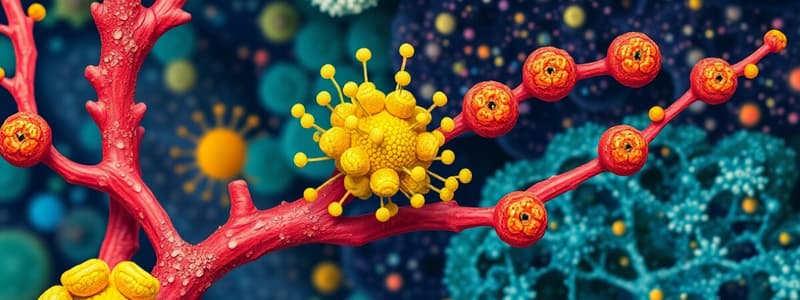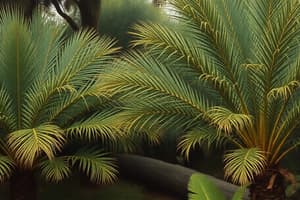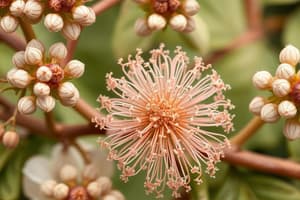Podcast
Questions and Answers
What adaptation observed in progymnosperms from the late Devonian period is characteristic of seed plants?
What adaptation observed in progymnosperms from the late Devonian period is characteristic of seed plants?
- Exclusive reliance on insect pollination.
- Ability to thrive in aquatic environments. (correct)
- Acquisition of traits related to seed development.
- Development of palmlike leaves and large cones.
Which of the following best describes the evolutionary trend in seed plant reproduction?
Which of the following best describes the evolutionary trend in seed plant reproduction?
- Increased dependence on external moisture for spore dispersal.
- Shift from heterospory to homospory. (correct)
- Shift from homospory to heterospory.
- Exclusive reliance on water for fertilization.
How does the structure of gymnosperm megaspores differ from that of angiosperm megaspores?
How does the structure of gymnosperm megaspores differ from that of angiosperm megaspores?
- Gymnosperm megaspores lack an integument, while angiosperm megaspores have one.
- Gymnosperm megaspores have one integument, while angiosperm megaspores usually have two. (correct)
- Gymnosperm megaspores have multiple integuments, while angiosperm megaspores have none.
- Gymnosperm megaspores have two integuments, while angiosperm megaspores have one.
Which of the following is a critical advantage that seeds have over spores?
Which of the following is a critical advantage that seeds have over spores?
Which of the following statements accurately describes the relationship between gymnosperms and angiosperms?
Which of the following statements accurately describes the relationship between gymnosperms and angiosperms?
Which phylum of gymnosperms relies on insects like beetles for pollination, similar to some angiosperms?
Which phylum of gymnosperms relies on insects like beetles for pollination, similar to some angiosperms?
Which characteristic distinguishes Ginkgo biloba from other gymnosperms?
Which characteristic distinguishes Ginkgo biloba from other gymnosperms?
Which of the following describes the role of megasporangia in seed plants?
Which of the following describes the role of megasporangia in seed plants?
What unique reproductive adaptation is found in Ephedra, a genus within the phylum Gnetophyta, compared to other gymnosperms?
What unique reproductive adaptation is found in Ephedra, a genus within the phylum Gnetophyta, compared to other gymnosperms?
What evolutionary challenge do pines address with wind-dispersed pollen, despite its inefficiency?
What evolutionary challenge do pines address with wind-dispersed pollen, despite its inefficiency?
In the life cycle of a pine, how are microspores dispersed from the sporophyte?
In the life cycle of a pine, how are microspores dispersed from the sporophyte?
What is the main feature that distinguishes gymnosperms from angiosperms regarding their seeds?
What is the main feature that distinguishes gymnosperms from angiosperms regarding their seeds?
How do secondary compounds in plants, such as those found in poison oak and ivy, primarily function?
How do secondary compounds in plants, such as those found in poison oak and ivy, primarily function?
What is the significance of specialized flowers in angiosperms?
What is the significance of specialized flowers in angiosperms?
What is the primary function of a fruit in angiosperms?
What is the primary function of a fruit in angiosperms?
Which of the following best explains the coevolutionary relationship between flowers and their pollinators?
Which of the following best explains the coevolutionary relationship between flowers and their pollinators?
Which component of a flower receives pollen?
Which component of a flower receives pollen?
What adaptation do some frugivorous animals have that allows seeds to pass through their digestive tract?
What adaptation do some frugivorous animals have that allows seeds to pass through their digestive tract?
How might a seed coat need 'disruption' to assist in the growth of a seedling?
How might a seed coat need 'disruption' to assist in the growth of a seedling?
Which phylum of gymnosperms would include pine, fir and redwood trees?
Which phylum of gymnosperms would include pine, fir and redwood trees?
What is the genus and species name of the seagrass deemed to be the largest plant on Earth?
What is the genus and species name of the seagrass deemed to be the largest plant on Earth?
Which of the following floral adaptations is most likely to attract nocturnal pollinators like moths and bats?
Which of the following floral adaptations is most likely to attract nocturnal pollinators like moths and bats?
What term refers to the transfer of pollen to the part of a seed plant containing the ovules?
What term refers to the transfer of pollen to the part of a seed plant containing the ovules?
From what structure does a seed develop?
From what structure does a seed develop?
What is the classification of living seed plants?
What is the classification of living seed plants?
Flashcards
Pteridospermales
Pteridospermales
Ancient gymnosperms from the late Devonian period, also known as seed ferns.
Progymnosperms
Progymnosperms
Plants from the late Devonian period (370 mya) that possess adaptations similar to seed plants.
Pollination
Pollination
Transfer of pollen to the part of a seed plant containing the ovules.
Ovule
Ovule
Signup and view all the flashcards
Ovule
Ovule
Signup and view all the flashcards
Seed
Seed
Signup and view all the flashcards
Gymnosperms and Angiosperms
Gymnosperms and Angiosperms
Signup and view all the flashcards
Gymnosperms
Gymnosperms
Signup and view all the flashcards
Phylum Cycadophyta
Phylum Cycadophyta
Signup and view all the flashcards
Phylum Ginkgophyta
Phylum Ginkgophyta
Signup and view all the flashcards
Megaspores
Megaspores
Signup and view all the flashcards
Microspores
Microspores
Signup and view all the flashcards
Phylum Gnetophyta
Phylum Gnetophyta
Signup and view all the flashcards
Male Cone
Male Cone
Signup and view all the flashcards
Female Cones
Female Cones
Signup and view all the flashcards
Phylum Coniferophyta
Phylum Coniferophyta
Signup and view all the flashcards
Flowers
Flowers
Signup and view all the flashcards
Anthos
Anthos
Signup and view all the flashcards
Angiosperms
Angiosperms
Signup and view all the flashcards
Fruit
Fruit
Signup and view all the flashcards
Ovary
Ovary
Signup and view all the flashcards
Fruits
Fruits
Signup and view all the flashcards
Ovule
Ovule
Signup and view all the flashcards
Sepals
Sepals
Signup and view all the flashcards
Petals
Petals
Signup and view all the flashcards
Study Notes
Gymnosperm Evolution
- In the late Devonian period, there were also ancient gymosperms called seed ferns, or Pteridospermales
- Fossil evidence indicates that by the late Devonian period (370 mya), some plants, called progymnosperms, had begun to acquire adaptations characteristic of seed plants
- Some progymnosperm species were homosporous, and some were heterosporous
- Archaeopteris is a progymnosperm
Pollen and Production of Sperm
- Microspores develop into pollen grains which contain the male gametophytes
- Pollination is the transfer of pollen to the part of the seed plant containing the ovules
Ovules
- An ovule consists of a megasporangium, megaspore, and one or more protective integuments
- Gymnosperm megaspores have one integument
- Angiosperm megaspores have two integuments
Evolutionary Advantage of Seeds
- A seed develops from the whole ovule
- A seed is a sporophyte embryo, along with its food supply, packaged in a protective coat
- Seeds have evolutionary advantages over spores:
- Seeds may remain dormant for days to years, until conditions are favorable for germination
- Seeds may be transported long distances by wind, animals, pr water
Gymnosperms and Angiosperms
- Living seed plants are divided into two clades: gymnosperms and angiosperms
- Gymnosperms appear early in the fossil record and dominated the Mesozoic terrestrial ecosystems
- Gymnosperms were better suited than nonvascular plants to drier conditions
- Angiosperms evolved from the gymnosperms
Phylum Cycadophyta
- Individuals have large cones and palm-like leaves, tracheids, ovulate and microsporangia cones on separate plants
- Cycads thrived during the Mesozoic era, but few species exist today
- Cycad sperm is multiflagellated, and some species rely on insects like beetles for pollination, similar to angiosperms
Phylum Ginkgophyta
- This phylum consists of a single living species: Ginkgo biloba
- Ginkgo biloba has a high tolerance to air pollution and is cultivated as a popular ornamental tree, with tracheids, ovules, and microsporangia on separate plants
- Ginkgo biloba sperm is also multiflagellated
- The fleshy seed coat of Ginkgo biloba has a vile odor due to butanoic and hexanoic acids, similar to fatty acids found in rancid butter and Romano cheese
Heterospory
- The ancestors of seed plants were likely homosporous, while seed plants are heterosporous
- Megasporangia produce megaspores that give rise to female gametophytes (seeds)
- Microsporangia produce microspores that give rise to male gametophytes (pollen)
Phylum Gnetophyta
- This phylum comprises three genera
- Gnetophyte species vary in appearance and habitat; some are tropical, while others live in deserts
- Gnetophytes have tracheids and vessel elements, non-motile sperm, and ovulate and microsporangiate cones on separate plants
- Ephedra exhibits double fertilization like angiosperms, but it produces extra embryos instead of a 3n endosperm
Cones
- Male cones release pollen grains and rely on wind to reach female cones
- Female cones have ovules on protruding scales and product seeds when fertilized
- Wind dispersal of pollen is highly inefficient and pines have been using it to pollinate successfully for 200 million years
Pine Life Cycle
- The pine tree is the sporophyte and produces sporangia in male and female cones
- Small cones produce microspores called pollen grains that each contain a male gametophyte and are dispersed by wind
Gymnosperm Characteristics
- Gymnosperms bear "naked" seeds, typically on cones, that are not enclosed by ovaries
- Gymnosperms consist of four phyla: Cycadophyta, Ginkgophyta, Gnetophyta, and Coniferophyta
Phylum Coniferophyta
- Coniferophyta is the largest of the gymnosperm phyla
- Most conifers are evergreens, carrying out photosynthesis year round, and possess tracheids, non-motile sperm, and ovulate and microsporangiate cones on the same plant
- Pine trees usually disperse their offspring via windblown seeds
- Cones are modified leaves
Asexual Plant Reproduction
- A species of sea grass Posidonia australis, in Shark Bay, Australia is believed to be the largest plant on Earth
- Samples spanning 111 miles were proven to belong to a single plant by genetic testing
- The existing meadows are a single plant that originated from a seed 4500 years ago, and its underground root system is home to marine animals
Flower Structure
- A flower is a specilized chute with up to tour types of modified leaves:
- Sepals enclose the flower
- Petals attract pollinators with bright colors
- Stamens produce pollen on terminal anthers
- Carpels produce ovules
- A carpel consists of an ovary at the base and a style leading up to a stigma, where pollen is received
Angiosperm Adaptations
- Angiosperms are seed plants with reproductive structures called flowers and fruits, making up the clade of plants known as vessel seeds
- Angiosperms are the most widespread and diverse of all plants
Flower Diagram
- Flowers have a stigma, carpel, style, ovary, stamen, anther, filament, petal, sepal, and ovule
Fruits
- A fruit (the ovary) typically consists of a mature ovary but can also include other flower parts
- Fruits protect seeds and aid in their dispersal
- Seeds can be carried by wind, water, or animals to new locations
Pollination Coevolution
- Nectar and brightly colored reproductive parts will attract animal dispersers
- Animals have adapted to plant phenolic secretions, and many plants have coevolved adaptations to facilitate pollination including:
- Colors and patterns
- Flower structure
- Odors
- Nectar
Angiosperm Characteristics
- All angiosperms are classified in a single phylum, Anthophyta (Magnoliophyta)
- The name angiosperm comes from the Greek word Anthos meaning flower
- Flowers are angiosperm structures specialized for sexual reproduction
- Many species of angiosperms are pollinated by insects or animals
- While others are wind pollinated, and in some cases pollination occurs via water transport
Frugivorous Seed Adaptations
- Frugivorous animals have coevolved unique adaptations with fruit-bearing plants
- Seeds coats need to be protected going through the digestive tract
- Some seeds are resistant to digestive enzymes and can withstand low pHs
- Some seeds actually need disruption of the seed coat to germinate, accomplished by either acid/enzyme action, or scarification to start the seed formation
Studying That Suits You
Use AI to generate personalized quizzes and flashcards to suit your learning preferences.




